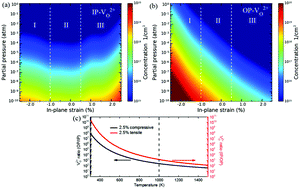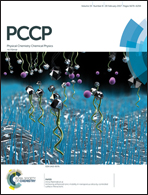Strain effects on oxygen vacancy energetics in KTaO3†
Abstract
Due to lattice mismatch between epitaxial films and substrates, in-plane strain fields are produced in the thin films, with accompanying structural distortions, and ion implantation can be used to controllably engineer the strain throughout the film. Because of the strain profile, local defect energetics are changed. In this study, the effects of in-plane strain fields on the formation and migration of oxygen vacancies in KTaO3 are investigated using first-principles calculations. In particular, the doubly positive charged oxygen vacancy (V2+O) is studied, which is considered to be the main charge state of the oxygen vacancy in KTaO3. We find that the formation energies for oxygen vacancies are sensitive to in-plane strain and oxygen position. The local atomic configuration is identified, and strong relaxation of local defect structure is mainly responsible for the formation characteristics of these oxygen vacancies. Based on the computational results, formation-dependent site preferences for oxygen vacancies are expected to occur under epitaxial strain, which can result in orders of magnitude differences in equilibrium vacancy concentrations on different oxygen sites. In addition, all possible migration pathways, including intra- and inter-plane diffusions, are considered. In contrast to the strain-enhanced intra-plane diffusion, the diffusion in the direction normal to the strained plane is impeded under the epitaxial strain field. These anisotropic diffusion processes can further enhance site preferences.



 Please wait while we load your content...
Please wait while we load your content...